How Employee Wellbeing Drives Productivity and Engagement: Insights for U.S. Businesses
Last Updated Oct 22, 2025

A new hire walked in on day one, energized and ready to dive in. Six months later, they were barely making it through the week. The spark was gone. They stopped joining team lunches. Their camera stayed off in meetings. Their work was... fine, but not inspired.
Their manager thought they just weren’t a good fit. But the truth? They were overwhelmed, lonely, and quietly drowning in stress—like so many others.
This wasn’t a performance issue. It was a wellbeing issue.
Employee wellbeing isn’t about yoga classes or free smoothies. It’s about supporting the whole person—mentally, physically, socially, financially, and professionally—so they can thrive at work and in life.
Transform your office into a place where energy, purpose, and connection thrive. Here's how to start building a culture of true wellbeing.
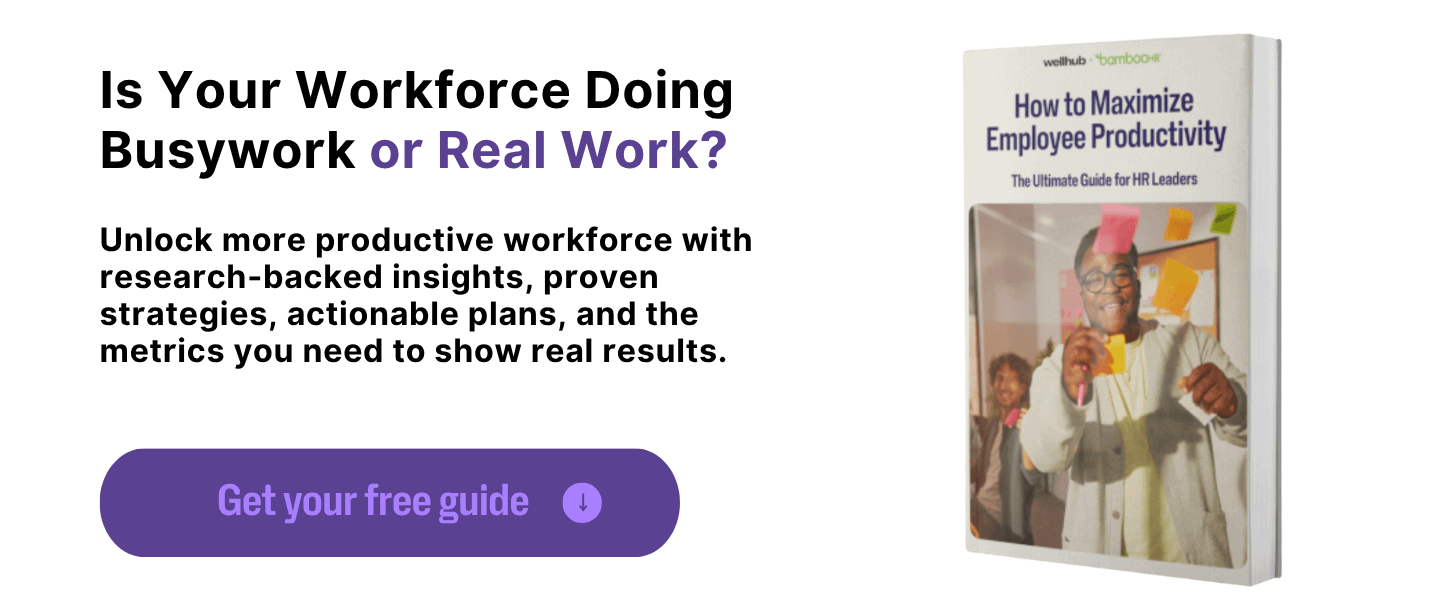
What You’ll Learn:
- A Complete Definition of Employee Wellbeing: What it really means to support the whole person at work—across five key dimensions: mental/emotional, physical, social, financial, and professional health.
- The Five Dimensions Explained: A practical breakdown of each wellbeing pillar—what it covers, common challenges employees face (like stress, burnout, or financial strain), and why a holistic approach matters.
- The State of Employee Wellbeing Today: Current data from Gallup and Wellhub showing that only half of U.S. employees feel they’re “thriving,” and just 17% believe wellbeing is embedded in their company culture—highlighting a growing gap between expectations and reality.
- The Business Case for Wellbeing: Evidence that wellbeing drives measurable outcomes—higher engagement, productivity, retention, and culture. For example, 97% of CEOs say wellness programs improve productivity, and 85% of employees would leave an employer that doesn’t prioritize wellbeing.
- How to Build and Measure a Successful Program: A step-by-step playbook for HR—defining goals, assessing needs, budgeting, designing inclusive initiatives, tracking KPIs (like utilization, absenteeism, and ROI), and learning from real-world success stories like Aflac’s Wellhub program.
What is Employee Wellbeing?
Employee wellbeing is the overall state of a worker's health—emotional, physical, social, professional, and financial—in and out of work.
It reflects how supported, energized, and fulfilled someone feels as a person while contributing meaningfully to their organization. Supporting whole person wellbeing includes providing:
- Access to mental health resources
- Flexibility and autonomy
- Financial wellness tools
- Opportunities for growth and purpose
- A safe, inclusive environment
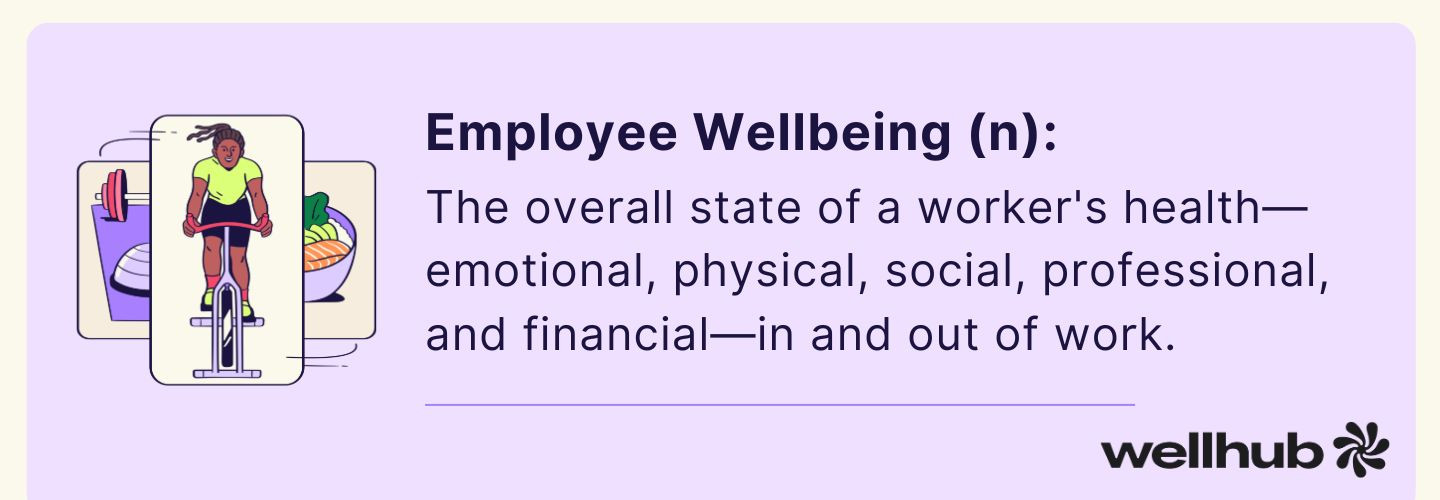
The 5 Dimensions of Employee Wellbeing
A holistic employee wellbeing approach considers a worker's welfare from every angle, including each of these five dimensions:
Mental/Emotional Wellbeing
Mental and emotional wellbeing go hand in hand. Together, they reflect an employee’s ability to manage stress, bounce back from challenges, and stay emotionally balanced. Poor sleep and workplace stress are top threats here—and they’re all too common. Helping employees build resilience and emotional awareness can make a meaningful impact on how they feel day to day.
Physical Wellbeing
Physical wellbeing is all about energy, movement, and rest. It includes how employees care for their bodies—through exercise, nutrition, and sleep. When employees feel physically strong and well-rested, they’re more likely to show up motivated and ready to take on the day. As Wellhub’s discovered in its State of Work-Life Wellness 2026 report, only 54% of employees say they’re in good shape, showing there’s still plenty of room for growth.
Social Wellbeing
Social wellbeing is rooted in connection. Whether it’s chatting with a coworker, grabbing lunch with a friend, or having support from family, relationships are essential to wellness.Employees with strong social ties are more likely to reach their wellness goals, especially when they feel seen, supported, and included.
Financial Wellbeing
Financial wellbeing reflects how confident and secure an employee feels about money—day to day and in the long run. It covers budgeting, financial literacy, and the ability to plan for the future. Unfortunately, 73% of employees say financial stress keeps them from investing in their wellbeing, which means cost is a barrier to healthier living for much of the workforce.
Professional Wellbeing
Professional wellbeing captures how employees feel about their work. Are they engaged? Do they find purpose in what they do? Do they feel like they’re growing? When people feel connected to their role—and supported in their development—they’re more likely to stay, contribute, and thrive. This pillar also ties into how employees view their company’s culture, leadership, and values.
Pillars of Wellbeing Cheat Sheet
| Pillar | What It Covers |
|---|---|
| Mental/Emotional | Stress, anxiety, resilience, mindfulness, emotional regulation |
| Physical | Exercise, sleep, nutrition, chronic condition prevention |
| Social | Relationships, community, connection, workplace belonging |
| Financial | Compensation, budgeting, financial literacy, stability |
| Professional | Purpose, career satisfaction, growth, engagement at work |
Employee Wellbeing in the U.S.: Where We Stand Today
The state of employee wellbeing in the U.S.? It’s complicated.
Workers understand just how essential their wellbeing is—not just for feeling good, but for doing great work. And yet, many still don’t feel fully supported by their employers.
According to Wellhub’s State of Work-Life Wellness 2026, here’s where the United States workforces stands today when it comes to their health, happiness, and hopes for the workplace:
- 86% of employees consider their wellbeing at work and their salary equally important.
- 92% say that when they prioritize their wellbeing, they are able to perform better at work.
- 89% say that spending time in wellness spaces (gyms, yoga studios, fitness classes) improves their ability to manage work-related stress.
- 87% indicated that they experienced burnout symptoms in the past year.
- 95% agree that physical, mental, emotional, and social aspects of wellbeing are interconnected, with 47% strongly agreeing.
- 70% say community or social support is extremely or very important for maintaining long-term wellness habits.
- Only 29% strongly agree that wellness is ingrained in their company’s culture.
- 86% agree their employer has a responsibility to help them tend to their wellbeing.
- 85% would consider leaving a company that does not focus on employee wellbeing.
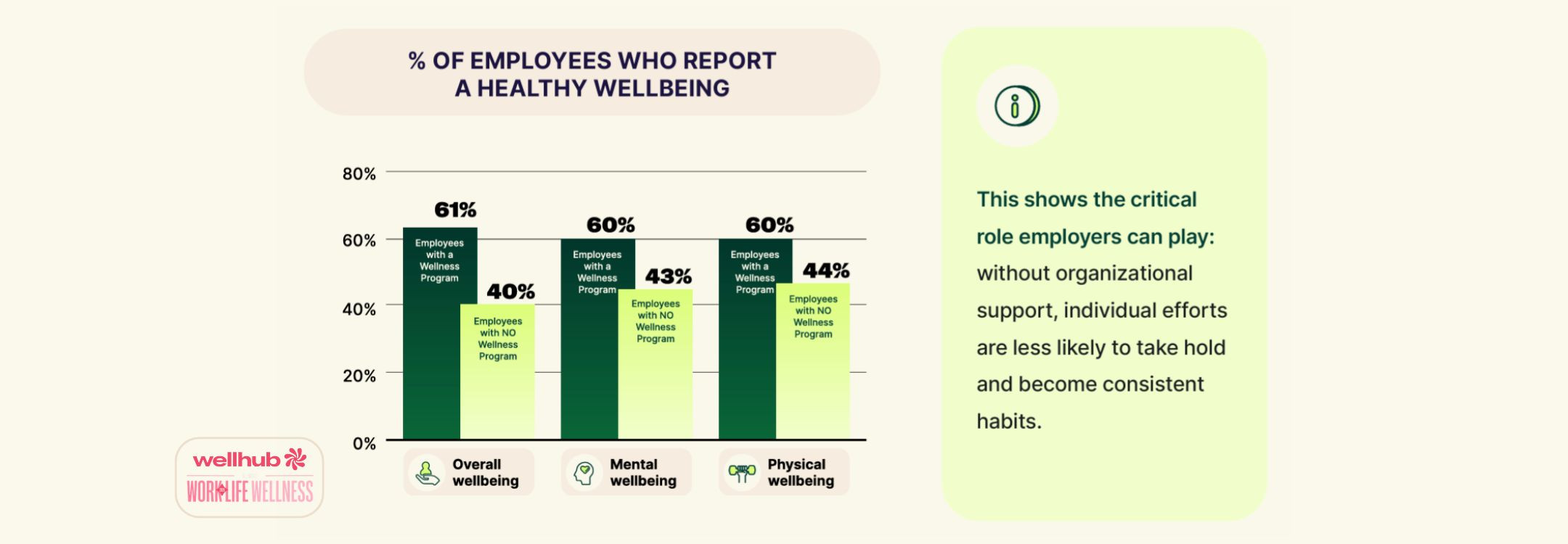
Benefits of Improving Wellbeing in the Workplace
Companies that promote employee wellbeing may see improvements in several key areas.
Enhanced Performance
Almost 90% of employees believe that their workplace performance improves when they prioritize their wellbeing, according to the State of Work-Life Wellness 2026 report. By encouraging employees to take time for their personal health — whether that means joining a local gym or spending more time with family and friends — you may see an uptick in employee wellbeing, productivity, and overall performance.
Increased Engagement
True engagement shows when employees are excited and encouraged to share their feedback and discuss new ideas. An engaged employee wants to put their best effort in.
However, if they're struggling physically or emotionally, it can have a dramatic impact on engagement. Those who exhibit symptoms of burnout or regular stress are less likely to contribute their whole selves to organizational goals. Giving employees tools to take control of their physical and mental wellbeing may bring a noticeable jump in engagement and morale.
Elevated Productivity
For many businesses, high productivity is a sought-after goal that can boost profits and cut expenses. Greater productivity can lead to technological advancements, improved customer service, and a strong competitive advantage.
Productively ultimately comes down to the state of your staff. Happier and healthier employees are often more engaged and focused, resulting in higher productivity and an overall sense of accomplishment.
One way to help increase your organization's productivity levels is with a wellness plan. Wellhub's Return on Wellbeing 2025 report revealed 97% of CEOs say their wellness program has at least slightly improved productivity, with 47% saying it has had a dramatic impact on overall workplace productivity.
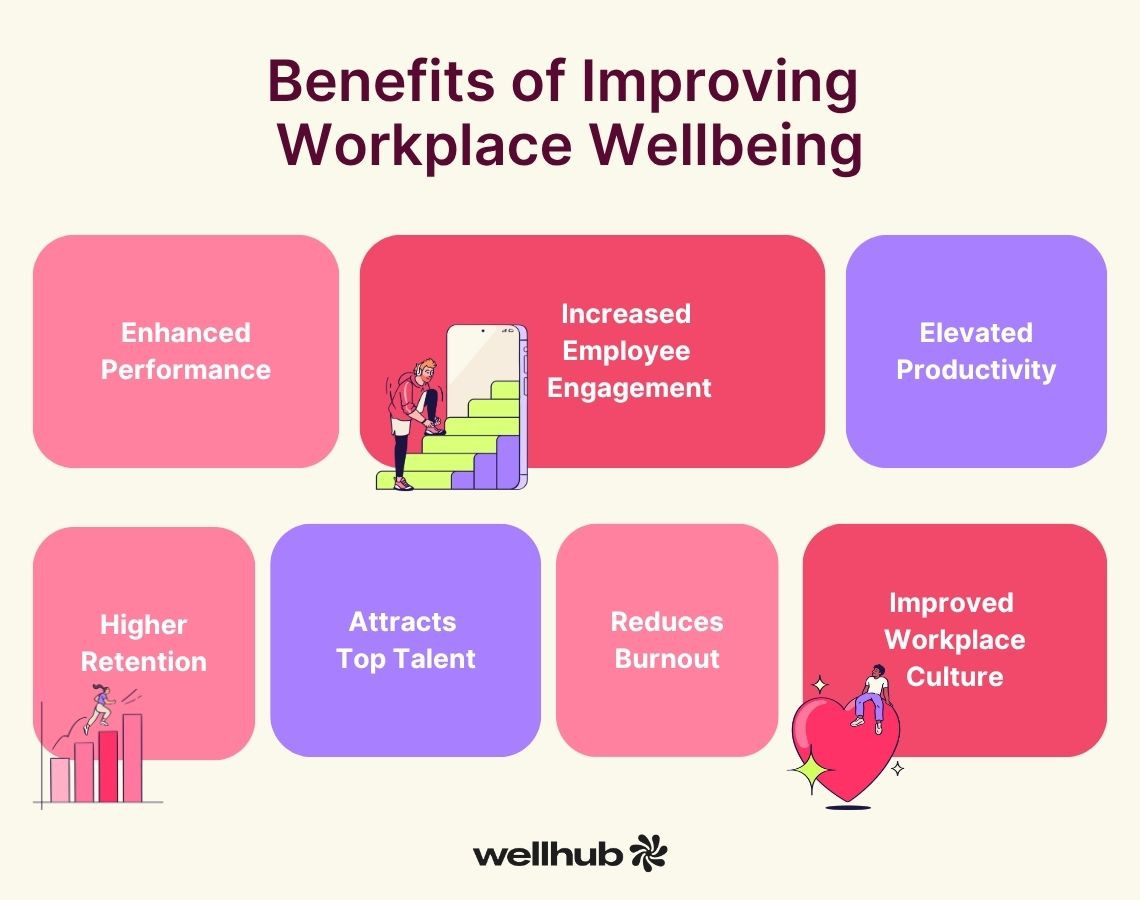
Higher Retention
Hiring someone new takes a lot of time and resources. You have to write a job description, review resumes, and interview candidates before settling on a good fit. But the work doesn't stop there. Your new hire will also need to catch up to speed on all tasks and internal processes.
Ideally, hiring only occurs when you open a new role, someone retires, or an employee's personal circumstances change. However, few businesses can say they haven't lost good workers to other organizations. That's where an employee wellbeing program can help.
Nearly three out of four of CEOs told Wellhub that their wellbeing program improves talent retention. But what do employees think? In the State of Work-Life Wellness 2026 report, 85% of workers said they would consider leaving an organization that doesn't focus on employee wellbeing. These numbers show that a wellbeing program may be what your organization needs to hold on to its best and brightest.
Attracts Top Talent
Finding workers with the right mix of education, skills, and experience is a top priority for most companies. However, in 2025, nearly 70% of organizations reported difficulties finding talented employees for full-time roles.
Implementing one of the best workplace wellness programs can make it easier to recruit top performers, especially considering that 85% of employees say they will only consider working for a company that cares about their wellbeing, as reported in the 2026 State of Work-Life Wellness study.
Improved Workplace Culture
Work isn't only about, well, work. It's a place where people spend the majority of their waking hours apart from their home. Your employees will develop new relationships, get to know each other's traits, and lean on each other in hard times. A solid culture that encourages healthy relationships can make the workplace a fun place to be.
How can organizations develop a positive workplace culture? Start with a wellbeing initiative. A program that encourages employee friendships and community can support your efforts to strengthen team bonds. Results from the 2026 State of Work-Life Wellness study reflect this:
- 83% of employees are more likely to join a workplace wellness initiative with a team or community component.
- 77% of employees with a wellbeing program believe HR genuinely cares about their wellbeing.
- 56% of employees report feeling extremely or very connected to their colleagues during shared wellness activities.
Reduces Burnout
Only 54% of employees say they have good or thriving mental health, according to the 2026 State of Work-Life Wellness. One way to help turn this burnout battle around is with a wellbeing initiative. Approximately 60% of employees with access to a wellbeing program report good or thriving mental health. Of those who don't have a wellbeing program, just 43% felt their mental health was good.
What Are U.S. Employees' Wellbeing Needs? (Generational Breakdown)
Wellbeing can mean different things to different people. Disparities are especially clear across generations. Gen Z and millennials place more emphasis on wellbeing than their older peers. Nearly 90% of both groups would leave a workplace that lacked wellbeing initiatives, followed by 81% of Gen Xers and 76% of baby boomers.
Here are some of the top wellbeing priorities by generation:
- Baby Boomers: Flexible retirement planning options
- Gen X: Opportunities for professional development and flexible schedules
- Millennials: Opportunities to progress in their career
- Gen Z: Clear paths to career growth, and working for companies with a strong sense of environmental and social responsibility
Finding ways to support your team through wellness initiatives, no matter what age group they belong to, may improve overall retention. It may also attract people eager to work for a company that understands — and meets — their needs.
Recognizing the Signs of Poor Employee Wellbeing
Take a look around your workplace. Is it buzzing with engaged workers eager to put their stamp on the organization? Do you see camaraderie and support, or do people seem a bit down? If it's the latter, look closer for symptoms of burnout. If left to its own devices, burnout can spread like wildfire through your organization, leaving a mess in its wake.
Here are a few signs that burnout is affecting your team:
Behavioral Signs
- An increase in social withdrawal or isolation from other colleagues
- Drop in engagement during meetings or workplace social events
- An uptick in employee irritability, frustration, and emotional outbursts
- Loss of enthusiasm in work projects and tasks
- Reduced confidence in the ability to meet goals
Productivity Signs
- A shift to focusing on basic tasks rather than sharing new ideas
- Inability to meet normal deadlines
- Far more errors and mistakes than normal
- Overall reduction in productivity
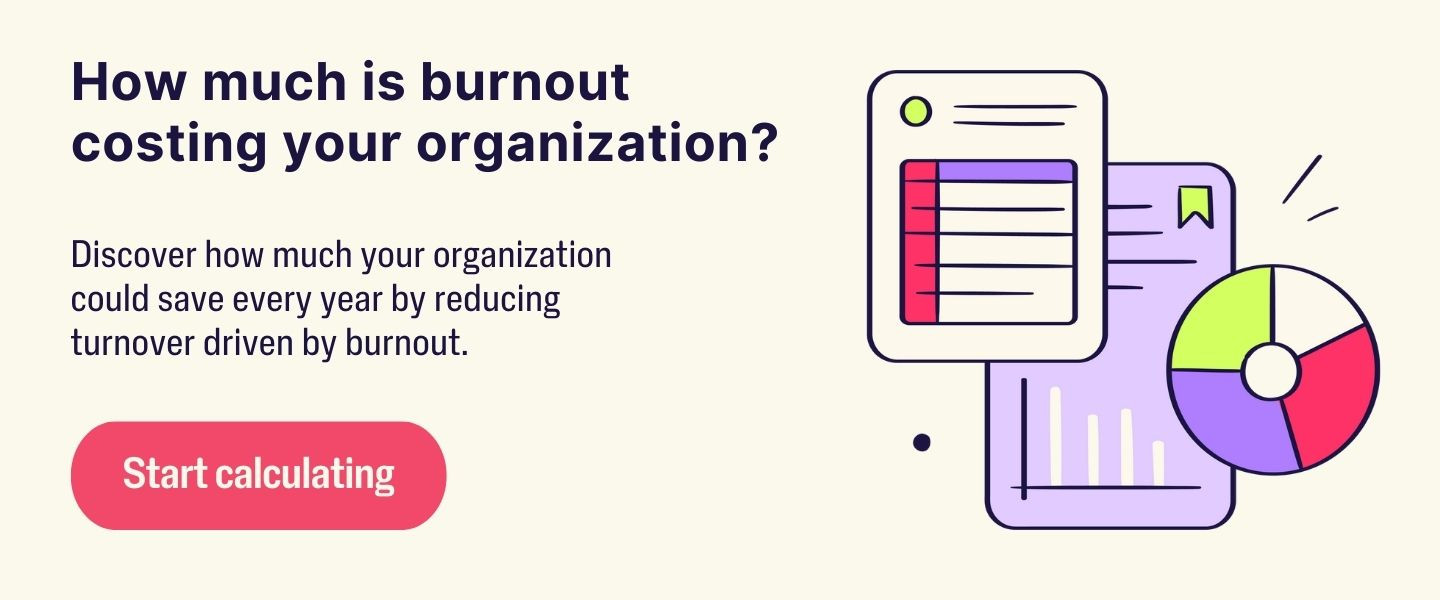
Physical and Mental Wellbeing Signs
- Easily fatigued and a noticeable lack of energy
- An increase in sick days and total absences
- Difficulty focusing on work tasks and making decisions
- Eating more or less than normal
- Changes to regular sleep patterns
Communication Signs
- Negative tone in emails and conversations
- Less talking during meetings or avoiding them altogether
- Reluctance to ask for help or inquire about daily tasks
- Drop in communication with colleagues and managers
Environmental Signs
- Higher turnover with no clear reason for it
- Toxic workplace where employees gossip about one another
- Drop in team morale and collaboration
- Uptick in absentee rates from company functions and activities
Wellness Program Employee Engagement KPIs
When implementing a wellness program, it's important to track its effectiveness, and adjust if necessary. For example, are employees taking advantage of it? If not, consider how to better promote the program or align it better with people's goals and preferences.
You can focus on several key metrics that gauge how employees are using the program, how it's affecting their wellbeing, and how it's impacting company-wide goals, such as productivity and turnover rate.
Useful KPIs to add to an employee engagement dashboard include:
- Utilization rate: Percentage of employees who enroll and actively engage in your organization's wellness plan. High utilization is what you're looking for, since it indicates that employees use the program and find that it meets their needs.
- Survey responses: Number of employees who share their thoughts about workplace wellness in a wellbeing survey. A solid response rate indicates people care about wellness and feel comfortable providing their input.
- eNPS (Employee Net Promoter Score): A measurement of employee loyalty and satisfaction derived by asking workers how likely they are to recommend your workplace to others. A high employee satisfaction score may indicate a healthy workplace and environment.
- Absenteeism: Frequency of unscheduled absences and sick days among your workers. A drop in the absenteeism rate after introducing a new wellness initiative may indicate improvements in employee health.
- Employee turnover rate: Percentage of workers who leave the organization over a set period. Lower turnover rates may indicate that employees appreciate a new wellness program, which can lead to higher retention and job satisfaction.
- Productivity: An increase in worker output and a decrease in errors points to a more productive workforce.
- Healthcare costs: A drop in healthcare policy costs and claims indicates an improvement in the health of your employees.
- Return on investment (ROI): To measure ROI, compare the financial benefits to the cost of the program. Savings can come from indicators like a reduction in healthcare premiums or reduced turnover. An ROI greater than 1.0 means the program is saving the company more money than it costs.

Best Practices for Building a Successful Wellbeing Program
Offering a wellness program tells your employees you care about them as a whole person. As the good vibes flow among your staff, you may notice more engagement and excitement in the workplace. Staff might be more willing to pitch in on employee gift ideas or lend a hand to a co-worker who needs help. Wellbeing programs are like that — they foster community and shared purpose among teammates.
But to reap the benefits of a wellbeing program, you'll want a clear plan in place. Keep these HR best practices to boost engagement in mind as you get started.
- Establish Clear Goals and Objectives
Use KPIs to help you determine the areas where you feel employees could benefit the most from wellbeing benefits.
Focus on the company's core goals and values as you define your objectives. For example, if your organization values long-term employees, tie the program to employee retention. Use that goal to make a case for why a wellbeing initiative is a valuable investment for the company.
- Assess Employee Needs
Encourage employees to honestly share their thoughts on the workplace with anonymous surveys. You can also organize focus groups, especially for workplaces where employees share specific concerns. Your goal is to define what employees want, not to just create a one-size-fits-all program that tries to please everyone.
- Identify Budget and Resources
Take a close look at your existing benefits budget. If there isn't enough room to finance a wellness initiative, discuss the matter with a decision-maker. Bring clear data that demonstrates why the business could benefit from a wellbeing program and what it entails. If you need to cut benefits to make room for a wellness program, think about which items you can leverage.
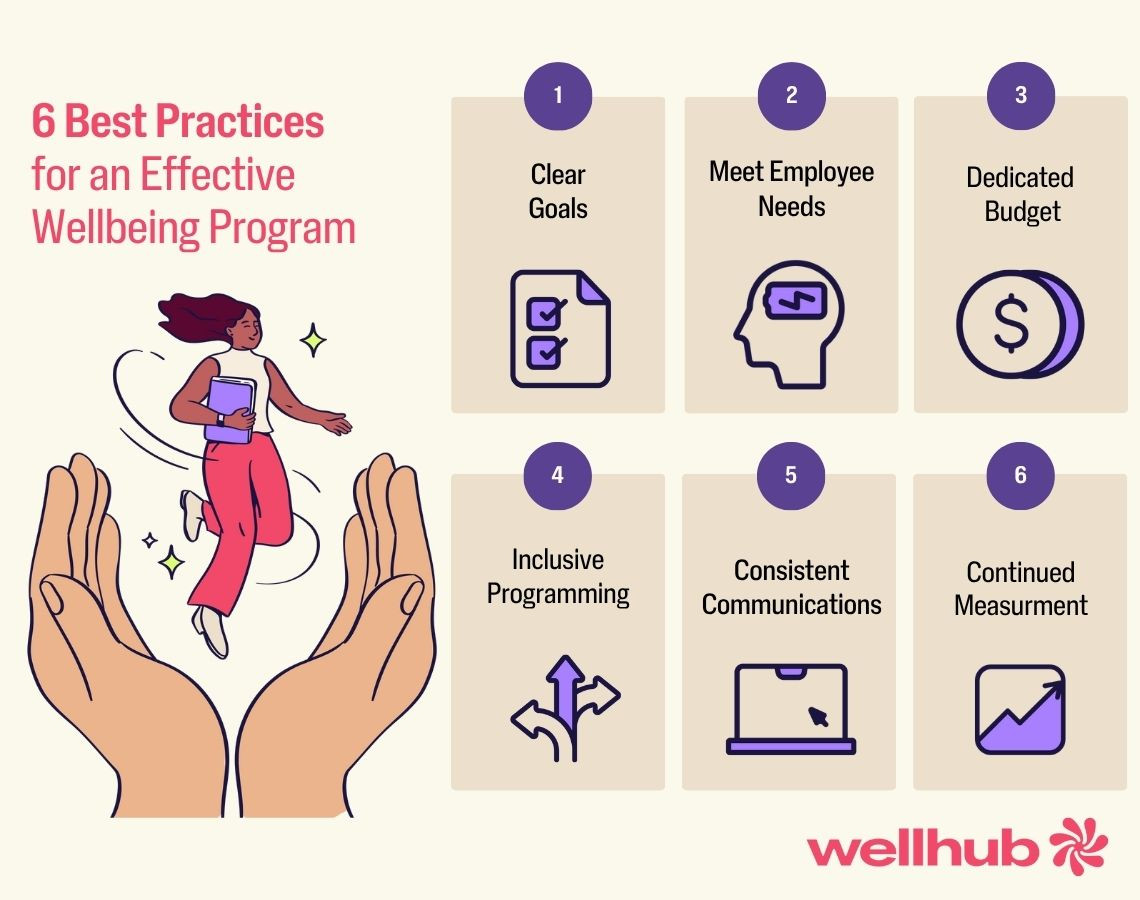
- Design a Comprehensive and Inclusive Program
Create a program that goes beyond standard physical health and addresses the other aspects of wellbeing, such as:
- Physical: Discounted memberships to local gyms or corporate exercise programs
- Mental: Flexible scheduling or dedicated work-from-home days
- Financial: Access to financial planning or budgeting services
- Social: Employee resource groups for women, new parents, and other groups
- Professional: Mentorship opportunities for employees looking for advancement
- Communicate and Promote the Program
Share the news of the wellness initiative with employees through email, flyers, and other workplace communications. Get the news out externally, too. Post about it on social media so that company followers see it. And don't forget to add it as a benefit to any open job descriptions — doing so may help your organization attract more talent.
- Launch and Measure
Make sure employees know when the program is live so they can enroll. Identify a few relevant KPIs to monitor its success, and start measuring results immediately. For example, if your goal is to reduce sick days, you can compare absentee rates before and after introducing the program.
Real Results: Aflac's Wellhub Case Study
In 2022, Aflac battled rising health premiums. The cause? An increasing number of employees signed up to take GLP-1 medication for weight control. Worried about the long-term impacts of the medication, the Aflac team decided to introduce a wellness initiative through Wellhub.
Fast forward three years, and 45% of Aflac's employees use Wellhub to support their overall health. The program was so successful, Aflac upgraded to the Wellhub+ plan and covered all costs of the Starter offering. Company executives take advantage of in-person moments and town halls to encourage staff to look after their health.
Prioritizing Employee Wellbeing Creates a Healthier, Stronger Workplace
Burnout, disengagement, absenteeism, and low morale can take a serious toll when employees lack support across all areas of their lives. The data is clear: many employees want more—but aren’t getting it.
That gap creates an opportunity. A comprehensive wellbeing program can address every dimension of employee health—mental, physical, social, financial, and professional. Wellhub’s State of Work-Life Wellness 2026 report found that 85% of employees would leave a company that doesn’t support their wellbeing. That’s a wake-up call for any organization looking to retain talent, increase productivity, and build a thriving workplace culture.
Speak with a Wellhub Wellbeing Specialist to build a program that supports your employees across every dimension of their wellbeing.
Category
Share

The Wellhub Editorial Team empowers HR leaders to support worker wellbeing. Our original research, trend analyses, and helpful how-tos provide the tools they need to improve workforce wellness in today's fast-shifting professional landscape.
Subscribe
Our weekly newsletter is your source of education and inspiration to help you create a corporate wellness program that actually matters.
Subscribe
Our weekly newsletter is your source of education and inspiration to help you create a corporate wellness program that actually matters.